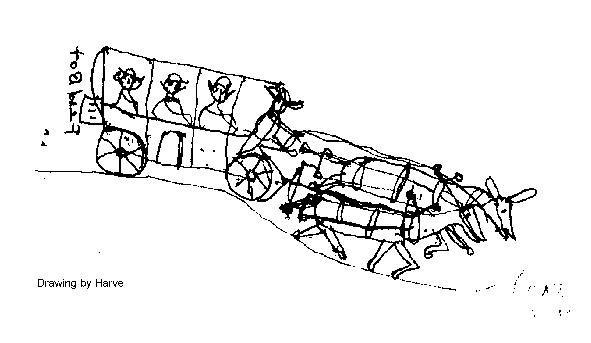Aha! We Made
It!
As told by
Mary Alice
Heritage History
The wagon wheels wobbled along the rutted
road. Each wooden spoked circle turned
separately rather than rotating as a unified motion. It was a battered and patched old covered wagon. Scarred but sturdy, it was drawn by a fine
team of work horses. Perched
precariously on the hard wooden driver’s seat was a sallow checked young lady,
Elsie Jane Sutton Tuttle, a/k/a “Jennie”.
The year, 1876, the month, early April.
Jennie held the reins just as rigidly as she did her expression. Her mouth was set in a straight, determined
line. Her hands were work-worn,
callused from eking out an exorable existence “back home in Indiana”. She had been born in an old sod shanty. The area where once the Sutton sod house
stood is now the campus of Ball State University in Muncie, Indiana.
A little two year old girlie nestled in a
homespun shawl just behind the wagon seat, was placidly sucking on a sugar
“tit”. Today it would be a plastic
“pacifier”. Raw sugar was wrapped in a
clean scrap of cotton cloth. Sometimes,
Jennie would also put a bit of molasses or sorghum on Arlies’s little fingers,
then give her a soft chicken feather which she contentedly played from finger
to sticky finger. At this time, it was
fortunate not to be aware that at the age of eight Arlie would die from
hydrophobia (rabies) after being severely attacked by a “mad” dog. No special treatment was available in 1883!
An occasional furtive glance backward toward the
interior of the wagon box showed the concern in Jennie’s pale blue eyes. Walking beside the wagon, possibly to
lighten the load, was a square shouldered stocky man. His broad-brimmed, slightly crumpled felt hat sat at a rakish
angle over dark blonde hair; his piercing eyes were deep blue and a
well-groomed mustache completed his rather mischievous countenance. In one hand was a walking staff for snakes,
man or beast whichever presented a problem first. A loaded rifle was slung handily over his shoulder, just in case
it might be needed. At his heels, a
limping coon hound completed a dejected, down-trodden picture of post war
travel; at least for poor ordinary folk – the Eli Enos Tuttle family. They were leaving Muncie, Indiana to seek
new land.
The high pitched wail of a tiny infant
brought the slowly moving procession to a “screeching” halt! The wiry woman set the brake, turned and
agilely slipped behind the canvas flap.
A crude crib was fashioned into a corner of the wagon box. Roughly woven willow branches securely made
the inner sides of a bed which held a baby girl. The infant was cushioned beneath and covered over by a colorful
hand stitched patchwork quilt. Fever flushed
her small features. Flailing fists and
tiny legs drawn upwards were symptoms of possible hunger pangs. Her age, about six weeks. The family had stopped at several settlements
along the way and begged to buy milk.
Indiana had the stigma of holding Northern sentiments during the Civil
War. No milk was available from those
living in Southern sympathizer territory.
No, not even for a starving baby would they empathize. The weary Jennie spoon fed the squirming
baby warm, weak tea, slightly sweetened.
Her Mother’s milk was non-existent, probably because of her own meager
diet. These were the trying times into
which my Mother was born.
Although this was a humble origin, Blanch Pearl Tuttle Irby lived past her 90th
birthday. When the old Hoosier country
doctor was queried about the wisdom of starting out on such a long, rough journey
with a six week old baby, he shrugged and said, “There’s plenty of room to bury
her between Indiana and Indian Territory!”
The trek by wagon from Muncie, Indiana, through Missouri and into Indian
Territory took over six weeks. (In the mid 1940’s, possibly 1946-47, Blanche Pearl,
her brother Harve, and daughter Dorothy visited in Indiana. They went out in the country and saw my
Mother’s birthplace. At that time it
was well preserved, and painted white.
In 1996, it would have been 120 years old.) Approximately four years later, in 1880, Arlie was now
six and Pearl about four, and the Tuttle’s had staked a claim near Indian
Territory. The double log cabin was
sparsely furnished, but scrubbed clean and neat. The pungent odor of freshly baked bread filled the air. “Spook” or “starter” had been carefully
protected in the basic food supplies and this type of yeast was “saved back”
from one batch of a rising bread to the next baking. Yeast, as we know it, was not always available. The shuffling, scraping sound along the dirt path
alerted Jennie to the approach of possible Indian visitors. (Theirs was a distinctive, light,
pigeon-toed moccasined gait.) Quickly
she pushed the heavy table against the already locked door. She hurried the two little girls under the
cot-like bed which filled the corner near the open hearth. Deftly she threw a comforter over the bed,
covering completely the bed, and children beneath. Sternly she warmed them not to make a sound… “Shhh!” With one swift movement, Jennie swept up the
three loaves of fresh bread from the roughly hewn table. Half opening a shuttered and hinged window,
she handed each one of the three Indian braves a loaf. Each just grunted a thank you in turn and
back down the path they shuffled. “Poor
souls, heathen though they might be, they are just hungry.” Shakily Jennie half spoke to herself and to
the little girls she had now retrieved from their hiding place. Such strength and courage was necessary in
that place and area of early settlement. My Mother told me this story of the fresh bread and
the Indian braves many times. She had
remembered it most vividly for she was frightened, I’m sure. (My sister Dorothy verifies Mother relating this
incident to her as well.)
